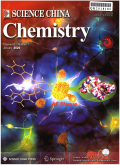- 钛学术文献服务平台 \
- 学术期刊 \
- 基础科学期刊 \
- 自然科学总论期刊 \
- 中国科学:化学(英文版)期刊 \
Asymmetric dearomatization enabled by chiral Brφnsted acid activation of ynamides
Asymmetric dearomatization enabled by chiral Brφnsted acid activation of ynamides
基本信息来源于合作网站,原文需代理用户跳转至来源网站获取
摘要:
Chiral Brφnsted acid catalysis has evolved into a powerful synthetic tool in asymmetric synthesis in the past two dec-ades or so.However,despite the broad scope of reactions achieved by chiral Brφnsted acid catalysis,they only involve the activation of a small number of functional groups.Among them,imines and carbonyls are most studied owing to the defined orientation of their lone pairs for hydrogen bonding with acids (Figure 1 a).In contrast,the activation of unsaturated C-C bonds by chiral Brφnsted acids toward asymmetric bond formation is much more challenging.In particular,the activation of C=C bonds has met with limited success.While asymmetric Michael-type addition has been known by indirect activation of C=C bonds (e.g.,ynones,ynoates,Figure 1b),asymmetric control initiated by direct protonation of C=C bonds is rare.This would generate an ion pair between a carbocation and a chiral counteranion(Figure 1a).Different from the strong directionality of hy-drogen bonding,asymmetric induction by counteranion ty-pically relies on much weaker and less directional electrostatic interaction [1].

推荐文章
甲醇在Br(o)nsted酸性离子液体中的脱水反应
酸性离子液体
甲醇
催化脱水
二甲醚
BrФnsted-Lewis双酸性离子液体的合成与应用
离子液体
BrФnsted-Lewis双酸性离子液体
催化剂
Brφnsted酸性离子液体催化合成油酸甲酯的研究
Brφnsted酸性离子液体
酯化
油酸甲酯
固定化Br(ō)nsted酸性离子液体催化酯化反应
离子液体
酸催化剂
固定化
酯化反应
浸渍法
溶胶-凝胶法
内容分析
关键词云
关键词热度
相关文献总数
(/次)
(/年)
文献信息
| 篇名 | Asymmetric dearomatization enabled by chiral Brφnsted acid activation of ynamides | ||
| 来源期刊 | 中国科学:化学(英文版) | 学科 | |
| 关键词 | |||
| 年,卷(期) | 2022,(1) | 所属期刊栏目 | HIGHLIGHTS |
| 研究方向 | 页码范围 | 3-4 | |
| 页数 | 2页 | 分类号 | |
| 字数 | 语种 | 英文 | |
| DOI | |||
五维指标
引文网络
引文网络
二级参考文献 (0)
共引文献 (0)
参考文献 (0)
节点文献
引证文献 (0)
同被引文献 (0)
二级引证文献 (0)
2022(0)
- 参考文献(0)
- 二级参考文献(0)
- 引证文献(0)
- 二级引证文献(0)
引文网络交叉学科
相关学者/机构
期刊影响力
中国科学:化学(英文版)
主办单位:
中国科学院
出版周期:
月刊
ISSN:
1674-7291
CN:
11-5839/O6
开本:
16开
出版地:
北京东黄城根北街16号
邮发代号:
创刊时间:
1950
语种:
eng
出版文献量(篇)
4060
总下载数(次)
0
总被引数(次)
11421
期刊文献
相关文献
推荐文献
- 期刊分类
- 期刊(年)
- 期刊(期)
- 期刊推荐
力学
化学
地球物理学
地质学
基础科学综合
大学学报
天文学
天文学、地球科学
数学
气象学
海洋学
物理学
生物学
生物科学
自然地理学和测绘学
自然科学总论
自然科学理论与方法
资源科学
非线性科学与系统科学
中国科学:化学(英文版)2022
中国科学:化学(英文版)2021
中国科学:化学(英文版)2020
中国科学:化学(英文版)2019
中国科学:化学(英文版)2018
中国科学:化学(英文版)2017
中国科学:化学(英文版)2016
中国科学:化学(英文版)2015
中国科学:化学(英文版)2014
中国科学:化学(英文版)2013
中国科学:化学(英文版)2012
中国科学:化学(英文版)2011
中国科学:化学(英文版)2010
中国科学:化学(英文版)2009
中国科学:化学(英文版)2008
中国科学:化学(英文版)2007
中国科学:化学(英文版)2006
中国科学:化学(英文版)2005
中国科学:化学(英文版)2004
中国科学:化学(英文版)2003
中国科学:化学(英文版)2002
中国科学:化学(英文版)2001
中国科学:化学(英文版)2000

 免费查重
免费查重










